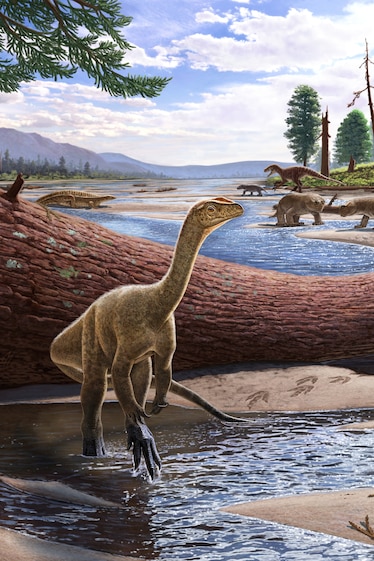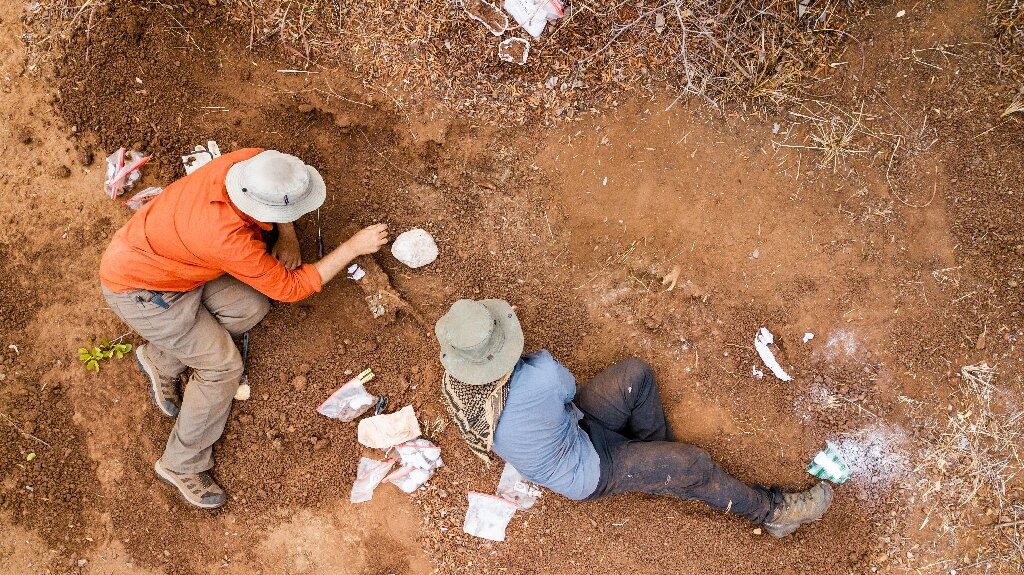Found in what is now Zimbabwe, the relatively small sauropod ancestor is helping reveal how dinosaurs first spread across ancient Earth.

In a braided river system in what’s now northern Zimbabwe 230 million years ago, a distant ancestral cousin of the giant long-necked sauropod dinosaurs roamed. Bones of this dinosaur, called Mbiresaurus raathi, have been unveiled as the oldest definitive dinosaur fossils in Africa.

The long-necked dinosaurs known as sauropods were the biggest animals to ever walk on land. But a stunningly complete skeleton found in northern Zimbabwe provides a reminder that these giants—some of which reached masses of more than 60 ton—had somewhat more modest beginnings.

The newfound fossil, unveiled today in the journal Nature, is the oldest definitive dinosaur discovered in Africa, dated to some 230 million years ago, during the Triassic period. The animal is also one of the earliest known ancestors to sauropods, the group that includes iconic long-necked giants such as Brachiosaurus and Brontosaurus. Even though the animal was nearing maturity when it died, experts estimate it would have been less than two feet tall at the hip.

With a small head, a set of leaf-shaped teeth, and a neck of modest length, “it’s almost like a generic dinosaur, if you had a kid draw a dinosaur and make it not a meat eater,” says Chris Griffin, a paleontologist at Yale University who conducted the research while a Ph.D. candidate at Virginia Tech.

Its scientific name, Mbiresaurus raathi, honors Mbire, a historical empire of Zimbabwe’s Shona people that once included the site where the fossil was unearthed. The dinosaur is also named for South African paleontologist Michael Raath, whose work in the area in the 1990s helped lead to its discovery.
Due to their age, Mbiresaurus and other fossils found alongside it shed light on how dinosaurs first arose and spread across ancient Earth during the Triassic, which stretched from 252 million to 205 million years ago. Bookended by two mass extinctions and filled with major climatic shifts, the Triassic was a critical period of transition for life on Earth. During this time, the ancestral lines of several key reptile groups first started to split from one another, giving rise to dinosaurs as well as crocodilians and the flying reptiles known as pterosaurs.

A new site of old dinosaurs
“In Pangaea you can walk from the north pole to the south pole. There are no giant physical barriers we can see, like giant mountain chains,” says study co-author Sterling Nesbitt, a paleontologist at Virginia Tech and Griffin’s former Ph.D. adviser. “But there are some kinds of climatic barriers.”

Reconstructing how life responded to these barriers is tricky with clues from only a few scattered fossil sites. Based primarily on early Triassic specimens from Argentina and Brazil, paleontologists think that during the dinosaurs’ start, the wildlife was separated by deserts that flanked the Equator. That got Griffin thinking: Southern Africa has rocks just as old as those in Argentina and Brazil, so would these deposits also hold the world’s oldest dinosaurs?

Griffin visited Zimbabwe in 2015 and met a team of local paleontologists and museum staff who were keen to work together to find out. “We had been working in the area before, but with limited resources and also expertise,” says study co-author Darlington Munyikwa of the National Museums and Monuments of Zimbabwe. “It was very important for us to be a partnership.”
During this visit, Griffin stumbled across a 1992 paper co-authored by paleontologist Michael Raath that described sites in the Dande communal lands, a tribal tract in northern Zimbabwe near the Zambian and Mozambican borders. To Griffin’s delight, the sites Raath described bore the bones of a triangle-headed Triassic reptile called a rhynchosaur. Based on South American fossils, Griffin knew that rocks old enough to bear rhynchosaurs were also of the right age to capture the oldest dinosaurs.

Thanks in part to a grant from the National Geographic Society, Griffin returned in late July 2017 and retraced Raath’s footsteps with a team of local paleontologists. He recalls the cool breeze of a Zimbabwean winter’s morning rustling the foliage along dry riverbeds and stingless gnat-size bees known as mopane flies buzzing around their heads as the researchers got to work.

From humble origins

Mbiresaurus stands out because it helps reveal the anatomy of the earliest sauropodomorphs, says Chapelle, an expert on this group of dinosaurs. For instance, the hip strikes Chapelle as especially primitive-looking when compared to those of later dinosaurs.
The site has also helped paleontologists learn more about the ecosystem that Mbiresaurus called home: a braided river system that flowed quickly enough to tumble rocks and form the pebbles of the Pebbly Arkose Formation, the specific rock layers in which Mbiresaurus was found.

Using Mbiresaurus and other Triassic fossils, Griffin’s team analyzed how dinosaurs may have spread out across ancient Earth. Their findings support the idea that dinosaurs arose in the southernmost reaches of Pangaea, and the researchers estimate that the animals likely started expanding north after 230 million years ago.